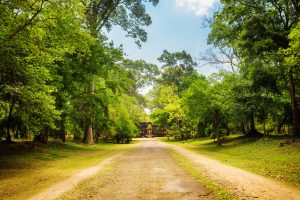The U.N. Climate Change Conference just concluded in Glasgow. As one of the conference’s achievements, as of November 10, 138 countries had signed on to a pact that would commit them to ending and reversing forest lost and land degradation by 2030. Yet some key Southeast Asian countries — Cambodia, Laos, Myanmar, and Thailand — have declined to join the list, even though this region is home to about 15 percent of the world’s tropical forests.
It appears that these countries still have not signed the declaration, which means they are not ready to pledge to zero deforestation and land degradation, reduce vulnerability, and incentivize sustainable agriculture.
Over the past two decades, Cambodia has lost 28 percent of its tree cover — equivalent to 2.46 million hectares, according to the Global Forest Watch dataset. The annual rate of wood loss expanded by almost 300 percent during the same period. This figure is a much higher percentage than larger, forested nations like Brazil and Indonesia. In the same period, the Brazilian forest has lost 12 percent of its tree cover and Indonesia has lost 10 percent.
As a result, Cambodia has about 8.5 million hectares of forest cover, or 46.86 percent of its territory, based on the 2018 natural resource evaluation by the Ministry of Environment released in September of this year. That figure includes rubber, oil palm, and other fruit crops areas throughout the nation.
If the current rate of forest loss continues unchanged, we can estimate that Cambodia will lose about 14 percent or 1.23 million hectares of its tree cover in the next decade. Forest cover will significantly decrease from current figures. However, Cambodia may increase forest cover if the cleared land is converted into agricultural areas and we count some plantation regions as forest cover area.
Much of this forest loss is likely the result of illicit operations. From 2000 to 2019, the annual national income from timber, paper, and publishing averaged $31.15 million, the equivalent of 0.39 percent of the mean yearly GDP at the same period, with a growth rate of 2.1 percent per year, according to the national account of the National Institute of Statistics. But a report from the Environmental Investigation Agency showed that Cambodia exported $385 million in raw timber to Vietnam in 2015 alone.
While it may be difficult to get clear data on how much money is being generated from the loss of Cambodia’s forests, it is clear that indigenous peoples and local peoples do not earn much from the forest.
For example, a 2018 research paper by Sareth Nhem, Young Jin Lee, and Sopheap Phin covering 277 households across 11 community forests and 14 villages in Kampong Thom province found that households experienced a median annual forest income of $271.39, making up 35 percent of their total income sources on average.
Authorities in Cambodia must act to reverse deforestation. There are many things to do, for example explicitly developing national frameworks for climate change resilience and sustainable economic growth in the medium and the long run.
In developing a policy framework, the government should have a clear policy direction and vision. Specifically, it should announce the percentage of forest cover the government aims to protect in the long run. The authorities should try to estimate the forest land that will need to be cleared in the future for the development of agriculture, infrastructure, living communities, and other industries.
At the same time, the government should consider developing and updating infrastructure development mapping. To do this, it will help to know what are the main regions of forest that will not be impacted by further infrastructure development.
High commitment and hard work at the political level, in the relevant ministries, and down to the rangers are the only pathways to success in the protection of natural resources. Collaboration among shareholders is important in the long term for natural resources and biodiversity development. Government action alone is insufficient; citizens and civil society across the region want to participate in the development process, too.
If Cambodia doesn’t sign ultimately sign the promise to stop deforestation and land degradation, it means that the country is not yet ready to commit in terms of the nation’s needs, resources, capacity, and direction. Developed economies and private companies are making efforts to help developing nations protect their forests through carbon emission trading. Cambodia can benefit and would be well served to protect the forest to absorb more carbon dioxide for the good of the world.

































